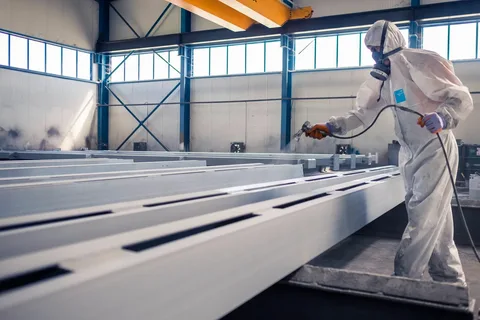Industrial Coating Market in Harsh Environments

Industrial Coating Market plays an indispensable role in protecting infrastructure and industrial assets operating in harsh environments from offshore oil platforms and desert solar farms to arctic pipelines and chemical processing plants. Industrial Coating Market continues to evolve as manufacturers design advanced coatings capable of withstanding extreme temperature fluctuations, chemical exposure, UV radiation, abrasion, and moisture ingress to ensure durability and operational reliability.
1. Understanding Harsh Operational Conditions
-
Saltwater, humidity, and corrosion: Marine and offshore installations face high corrosion risk due to salt spray and salt-laden humidity.
-
Extreme heat and UV exposure: Desert regions and tropical climates necessitate UV-stable and thermal reflective coatings to prevent substrate degradation.
-
Cryogenic or sub-zero conditions: Arctic pipelines, refrigerated storage tanks, and polar facilities require coatings that remain flexible and intact at extremely low temperatures.
-
Chemical and abrasion resistance: Facilities handling acids, alkalis, solvents, and particulate-laden operations demand mechanically and chemically resilient finishes.
2. Specialized Formulations for Corrosion Prevention
Effective corrosion-resistant coatings combine protective barrier layers and robust topcoats:
-
Epoxy primers with high adhesion and moisture resistance serve as the first defense.
-
Zinc-rich or sacrificial primers galvanically protect steel substrates.
-
Polyurethane or fluoropolymer topcoats seal the system, offering UV stability and chemical resistance. These multi-coat systems are engineered to survive decades under corrosive exposure.
3. UV-Resistant and Heat-Reflective Coatings
Heat and solar radiation accelerate degradation of both coating and substrate. To counteract:
-
Reflective ceramic additives reduce surface heat absorption.
-
Infrared-reflective pigments deflect solar energy and minimize thermal expansion stress.
-
Fluoropolymer or silicone topcoats shield against long-term UV damage while maintaining color stability and film integrity.
Such coatings preserve performance in desert power generation facilities, storage tanks, and surface piping.
4. Abrasion and Impact Resilience
In environments with particulate erosion or frequent mechanical contact:
-
Ceramic-filled coatings offer hardness and abrasion resistance.
-
Elastomeric formulations maintain flexibility under impact, preventing cracking.
-
High-solid epoxy or polyurethane systems resist chipping and wear from dust, gravel, or freight transit.
These systems prolong asset life in mining, bulk material handling, road transport, and harsh industrial zones.
5. Cold-Climate Coatings for Cryogenic and Arctic Use
In extreme cold, standard coatings can become brittle and lose adhesion. Cold-resilient alternatives include:
-
Specialized epoxy or urethane resins with low glass transition temperatures.
-
Flexible elastomeric layers that accommodate substrate movement and thermal cycling.
-
Corrosion-control primers rated for sub-zero use that retain protective integrity over freeze–thaw cycles.
These innovations defend pipelines, storage vessels, and structural steel in tundra and polar regions.
6. Chemical and Solvent Resistance in Aggressive Environments
Industries dealing with harsh chemicals utilize:
-
Epoxy novolacs and phenolic coatings with resistance to acids, alkalis, and solvents.
-
Polyurethane or PVDF systems that withstand chemical splash, fouling, and abrasive washdown.
-
Lined systems combining coating with grout or secondary liners for extreme exposure scenarios.
Such coatings are essential in chemical plants, wastewater treatment facilities, and offshore petrochemical installations.
7. Application Technologies for Extreme Settings
Effective deployment of harsh-environment coatings depends on precise application:
-
Robotic spray systems and electrostatic powder booths provide uniform sequencing and thickness control, driving consistency and reducing application failures.
-
Thermal-fluidized automated lines support powder coating of large metal parts with minimal VOC emissions.
-
Environmental containment systems regulate temperature and humidity during application, crucial in extreme heat or cold.
These application methods ensure that harsh-environment coatings perform as designed under rigorous service conditions.
8. Lifecycle Benefits and Maintenance Optimization
Protective coatings for harsh environments deliver long-term value by:
-
Minimizing maintenance cycles and recoat frequency.
-
Reducing downtime for asset refurbishment.
-
Lowering repair costs through fewer coating failures and corrosion events.
Such benefits are critical in offshore platforms, remote infrastructure, and industrial plants where access is costly or limited.
9. Regulatory and Environmental Compliance
In areas with tough climatic or sensitive ecological conditions:
-
Low-VOC and high-solid coatings reduce emissions during application.
-
Biocide-free antifouling systems minimize marine ecosystem impact.
-
Heat-reflective and energy-reducing coatings support environmental targets in solar and urban heat mitigation.
Compliance with environmental and occupational safety standards is integral to coating selection.
10. Emerging Innovations for Harsh Conditions
The market is yielding advanced solutions, such as:
-
Nano-engineered barrier coatings with reinforced mechanical and UV resistance.
-
Self-healing coatings that repair microcracks autonomously, slowing corrosion.
-
Sensor-integrated smart coatings monitoring structural health and environmental exposure in real time.
These innovations improve asset longevity and support proactive maintenance in extreme conditions.
11. Sector-Specific Industry Examples
-
Offshore Oil & Gas: Corrosion- and fouling-resistant systems for topside, hulls, and subsea structures.
-
Renewable Energy: UV and erosion-resistant finishes for wind turbines and solar collectors in desert or offshore settings.
-
Infrastructure: Bridges, pipelines, and concretes coated for salt spray, acid rain, or thermal cycling.
-
Mining & Heavy Industry: Abrasion-resistant, chemical-safe surfaces in bulk handling, kilns, and transport lines.
Each sector demands tailored coating strategies to address distinct environmental threats.
12. Strategic Recommendations for Coating Producers
To serve harsh environment markets, manufacturers should:
-
Prioritize R&D on multi-functional, environment-rated formulations.
-
Invest in robust application technologies and environmental control systems.
-
Offer turnkey coating systems with primers, topcoats, training, and inspection protocols.
-
Support certifications for corrosion resistance, UV stability, and low emissions.
-
Train field technicians in best practices for high-humidity, high-heat, or low-temperature coatings.
Conclusion
The Industrial Coating Market is essential to protecting assets in harsh environments where failure is not an option. High-performance coatings engineered for extreme corrosion, UV exposure, abrasion, chemical attack, or temperature extremes ensure infrastructure resilience and longevity. By combining specialized formulations, advanced application systems, and smart maintenance tools, manufacturers are re-engineering coating strategies to thrive in the world’s most demanding conditions.
- Art
- Causes
- Crafts
- Dance
- Drinks
- Film
- Fitness
- Food
- Jogos
- Gardening
- Health
- Início
- Literature
- Music
- Networking
- Outro
- Party
- Religion
- Shopping
- Sports
- Theater
- Wellness


